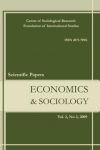WHY ARE RURAL COMMUNITIES
RELUCTANT TO ADOPT THE
STANDARD VERSION OF SROI?
WHY ARE RURAL COMMUNITIES
RELUCTANT TO ADOPT THE
STANDARD VERSION OF SROI?
Author(s): Fuminobu MizutaniSubject(s): Rural and urban sociology, Socio-Economic Research
Published by: Fundacja Centrum Badań Socjologicznych
Keywords: NFPs; rural community; SROI; autonomy; hands-on approach;
Summary/Abstract: Social Return on Investment (SROI) is an evaluation method that is often useful in assessing Not for Profit organizations (NFP). Its standard version has been widely adopted in the United Kingdom. However, there is a reluctance among East Asian rural communities to adopt standard SROI evaluation methods, even though they have been adopted for some NFPs in urban centers in the region in the past. NFPs in rural communities cannot bear the cost of sending representatives to meetings where drafts of potential regulations are discussed. However, the introduction of regulations for evaluating NFPs without representatives from rural communities could lead to the exclusion of pertinent voices key to the discussion. There are several reasons why the hands-on approach currently utilized by SROI evaluation methods appears unsuitable for rural communities. These communities are already aware of their aging populations and they have obligations to the welfare of their members that fall outside the scope of SROI. In addition to this, the main argument why rural communities are reluctant to adopt SROI methods is that it does not bring much benefit to these communities. However, discussing evaluation methods for NFPs could serve as a bridge with stakeholders in rural communities. Paradoxically, a nonstandard version of SROI that is calculated by those outside of NFPs may be a more suitable method for rural communities.
Journal: Economics and Sociology
- Issue Year: 16/2023
- Issue No: 3
- Page Range: 125-137
- Page Count: 13
- Language: English

